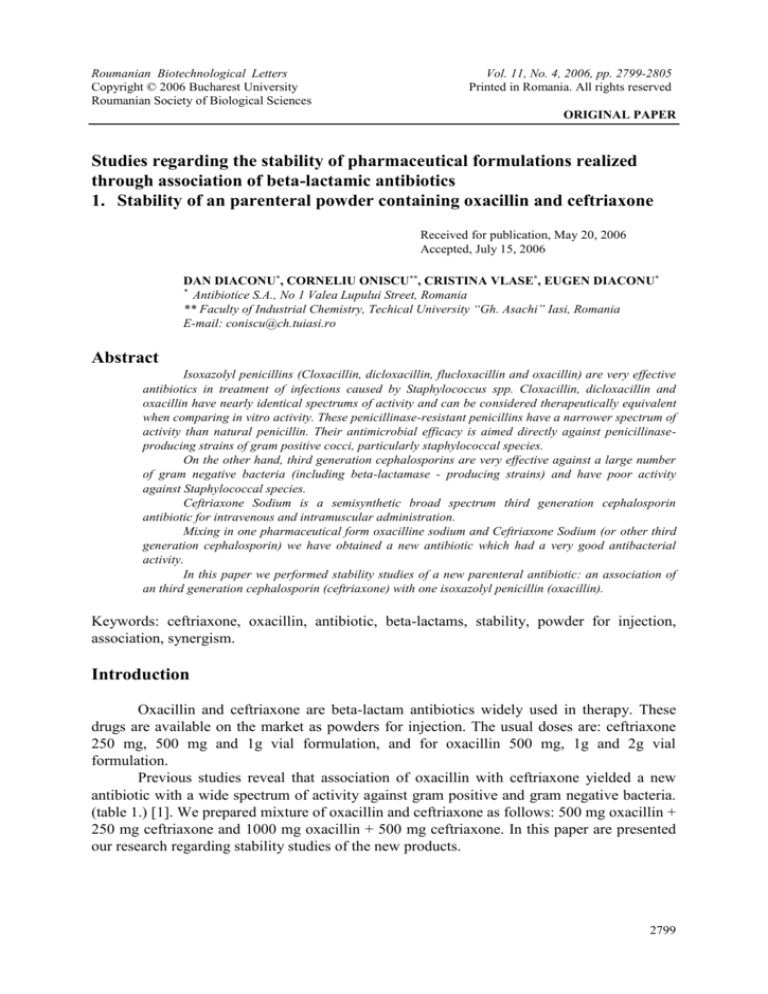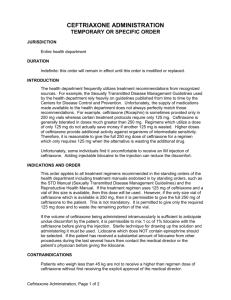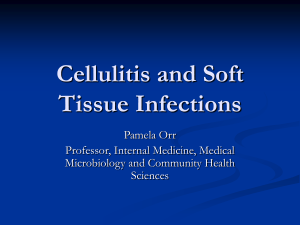
Roumanian Biotechnological Letters
Copyright © 2006 Bucharest University
Roumanian Society of Biological Sciences
Vol. 11, No. 4, 2006, pp. 2799-2805
Printed in Romania. All rights reserved
ORIGINAL PAPER
Studies regarding the stability of pharmaceutical formulations realized
through association of beta-lactamic antibiotics
1. Stability of an parenteral powder containing oxacillin and ceftriaxone
Received for publication, May 20, 2006
Accepted, July 15, 2006
DAN DIACONU*, CORNELIU ONISCU**, CRISTINA VLASE*, EUGEN DIACONU*
*
Antibiotice S.A., No 1 Valea Lupului Street, Romania
** Faculty of Industrial Chemistry, Techical University “Gh. Asachi” Iasi, Romania
E-mail: coniscu@ch.tuiasi.ro
Abstract
Isoxazolyl penicillins (Cloxacillin, dicloxacillin, flucloxacillin and oxacillin) are very effective
antibiotics in treatment of infections caused by Staphylococcus spp. Cloxacillin, dicloxacillin and
oxacillin have nearly identical spectrums of activity and can be considered therapeutically equivalent
when comparing in vitro activity. These penicillinase-resistant penicillins have a narrower spectrum of
activity than natural penicillin. Their antimicrobial efficacy is aimed directly against penicillinaseproducing strains of gram positive cocci, particularly staphylococcal species.
On the other hand, third generation cephalosporins are very effective against a large number
of gram negative bacteria (including beta-lactamase - producing strains) and have poor activity
against Staphylococcal species.
Ceftriaxone Sodium is a semisynthetic broad spectrum third generation cephalosporin
antibiotic for intravenous and intramuscular administration.
Mixing in one pharmaceutical form oxacilline sodium and Ceftriaxone Sodium (or other third
generation cephalosporin) we have obtained a new antibiotic which had a very good antibacterial
activity.
In this paper we performed stability studies of a new parenteral antibiotic: an association of
an third generation cephalosporin (ceftriaxone) with one isoxazolyl penicillin (oxacillin).
Keywords: ceftriaxone, oxacillin, antibiotic, beta-lactams, stability, powder for injection,
association, synergism.
Introduction
Oxacillin and ceftriaxone are beta-lactam antibiotics widely used in therapy. These
drugs are available on the market as powders for injection. The usual doses are: ceftriaxone
250 mg, 500 mg and 1g vial formulation, and for oxacillin 500 mg, 1g and 2g vial
formulation.
Previous studies reveal that association of oxacillin with ceftriaxone yielded a new
antibiotic with a wide spectrum of activity against gram positive and gram negative bacteria.
(table 1.) [1]. We prepared mixture of oxacillin and ceftriaxone as follows: 500 mg oxacillin +
250 mg ceftriaxone and 1000 mg oxacillin + 500 mg ceftriaxone. In this paper are presented
our research regarding stability studies of the new products.
2799
DAN DIACONU, CORNELIU ONISCU, CRISTINA VLASE, EUGEN DIACONU
Table 1.
No
Microorganism
oxacillin Na
1.
2.
3.
4.
5.
6.
Streptococcus pneumoniae
Staphylococcus aureus (12)
Staphylococcus aureus (2)R
Haemophylus influenzae
Escherichia coli
Proteus sp.
0,05
0,25
0,5
>64
>64
>64
C.M.I., g/ml
Ceftriaxone
Na
0,03
1,0
1,0
0,06
0,12
0,04
oxacillin Na:
ceftriaxone Na
= 2:1
0,02
0,2
0,1
0,02
0,4
0,02
Materials and methods
Oxacillin sodium is made by Aurobindo, India and has the following parameters:
Assay 100.9%
Impurity (A,B, C, D, E) <0.1%; sum=0.1%
Water: 9.6%
White crystalline powder
pH 7.1
ceftriaxone is supplied by High Tech, Korea an has the following parameters:
assay: 860.11 µg/mg
water content: 4.56%
White crystalline powder
pH 6.17
The powder mixture was dosed in 20 ml amber vials closed tight with rubber stopper and
Al cap. The powder was analyzed for performing the stability studies in dry form. After that we
perform stability studies of antibiotic in solution as well using suitable solvents (so called “in use”
stability testing). For this purpose the vials were kept 12 months at room temperature (25 ± 2ºC)
and 6 month at 40ºC (accelerated stability studies). The solutions in suitable solvents were kept
for few days at room temperature and in the refrigerator (2-5ºC)[6, 7].
For determination of the stability period of the powder in dry state we used the
isotherm procedure on long term, based mainly on degradation rate of active substances. In
this purpose we have determined the active substances content and related substances at three
month intervals. Tests were performed using 5 vials for one analyze and considering the mean
values. Interpolating the experimental values yield the mathematical model of the two
antibiotics degradation in dry state. The adequacy of mathematical model was assessed using
Fischer test for a confidence interval of 95%.
Based on mathematical model we assessed the stability period using a graphic method
[2], intersecting the curves described by degradation equations of active substances,
(respective the increase in degradation products content) with the limits described by
pharmacopoeia.
The admissibility conditions were established in accordance with main international
pharmacopoeias. [3,5]
Determinations of the active substances were performed using a HPLC system
Agilent, model 1100. The analytical methods we used were in accordance with USP 26. [3, 4]
2800
Roum. Biotechnol. Lett., Vol. 11, No. 4, 2799-2805 (2006)
Studies regarding the stability of pharmaceutical formulations realized through association of beta-lactamic antibiotics
1. Stability of an parenteral powder containing oxacillin and ceftriaxone
Admissibility conditions for powders:
ceftriaxone: 90-115%
oxacillin: 90-115%
related substances: max 1% each, sum < 5%
pH=6 – 8.5
appearance: white or almost white crystalline powder
Results and discussions
Stability studies
Long-term stability studies
Results were presented in table 2
Table 2. Stability studies on a mixture 500 mg oxacillin+250 mg ceftriaxone (as sodium salts)
Parameter
Ceftriaxone content,
mg/vial.
Oxacillin content
mg/vial.
Related substances:
individual
sum
pH
Appearance
Time, months
6
initial
3
9
12
253,5
250,5
248,0
248,07
246,1
499,25
496,65
493,8
490,45
486,85
max.0,45%
max.0,47%
1,45
1,66
2,36
2,68
3,05
6,88
Light
yellow
6,89
Light
yellow
6,76
Light
yellow
6,70
Light yellow
6,71
Light
yellow
max.0,49%
max.0,55%
max.0,55%
After 12 month at room temperature, ceftriaxone content had a 3% drop, and oxacillin
content drop almost 2.5%. pH has been stable, and the color of the mixture remain the same.
As it was already mentioned, modeling the degradation process was made considering
the variation in active substances content, related substances content in time (table 3.)
Table 3. Variation in Ceftriaxone and oxacillin content in time
Time, month
Content in ceftriaxone,
(% from declared content)
Content in oxacillin
(% from declared content)
Content in related substances,
% (as sum)
0
101,4
3
100,2
6
99,2
9
99,23
12
98,43
99,85
1,45
99,33
1,66
98,76
2,36
98,09
2,68
97,37
3,05
Data obtained experimentally were used for the evaluation of the order of reaction of
degradation of the two antibiotics in isotherm conditions and for the estimation of the
preservation of powder at 25ºC. The degradation graphics in picture 1 were obtained in a
graphic representation of the variations in time for the antibiotic concentration (as percent
from the quantity declared on the vial). Figure 1.
Roum. Biotechnol. Lett., Vol. 11, No. 4, 2799-2805 (2006)
2801
DAN DIACONU, CORNELIU ONISCU, CRISTINA VLASE, EUGEN DIACONU
Figure 1. The degradation of active substances from powder under preservations conditions at 25ºC for 12
months and the representation of regression equations.
As a result of interpolating the data obtained experimentally, the following regression
equations were obtained:
Degradation equation in time for ceftriaxone
C1= 0,2323 t+102,08; corelation coefficient =0,9574)
Degradation equation in time for oxacilline
C2= 0,2073 t+99,928; (corelation coefficient =0,9975)
Equation describing the growth of related substances content.
C3= 0,1407 t + 1,396; (correlation coefficient =0,9879)
Where C1= ceftriaxone content /vial (as % from the declared quantity per vial)
C2 = oxacillin content /vial (as % from the declared quantity per vial)
C3 = related substances content, % (as sum)
T = time in months.
The above equations define a line, which shows that antibiotic degradation appears after
an order 0 kinetic.
The graphic evaluation of stability period of the powder was achieved considering the
minimum value of time (in months) that satisfies all conditions:
Time where both antibiotics have a minimum 90% from the declared content / vial
(obtained by intersecting the lines described by the regression equations with the line
corresponding to the minimum admitted content /vial (picture 2a)
Time where the level of related substances is under the 5% limit ( obtained by intersecting
the line described by the equation giving the growth of related substances content with the
line indicating the maximum admitted content of 5%. (picture 2b).
2802
Roum. Biotechnol. Lett., Vol. 11, No. 4, 2799-2805 (2006)
Studies regarding the stability of pharmaceutical formulations realized through association of beta-lactamic antibiotics
1. Stability of an parenteral powder containing oxacillin and ceftriaxone
Figure 2. The graphic evaluation of stability period for the powder mixture.
As shown in picture 2, the content of active substances remains within limits foe about 4 years, but the content of
related substances overcomes the 5% limit after 26 months. Consequently, we can evaluate the powder’s stability
period to 26 months (2 years).
1.2. Accelerated stability studies of the powder in isotherm conditions
In table 4 are shown the results obtained under powder preservation conditions according
to the isotherm procedure at 40ºC for a period of 6 months.
After 6 months the content of active substances is still within limits, while the level of
related substances and the pH overcome it. Also we notice a strong change in the powder’s
color to yellow-brown. Therefore it was proved that the product cannot be preserved at
temperatures higher than 25C.
Table 4. Qualitative parameters of powder for injection at 40C (medium value per 5 vials)
Parameter
Content in ceftriaxone,
mg/vial
% from the declared content/vial
Content in oxacillin,
mg/vial
% from the declared content/vial
Related substances:
individual
sum
pH
Powder aspect
Time, month
initial
3 months
6 months
253,5
101,4
243,6
97,44
235,5
94,22
499,25
99,85
481,9
96,38
472,5
94,5
max.0,45%
1,45
6,88
Slightly yellow
max.1,47%
max. 3,85%
4,93
10,22
6,23
10,2
Slightly yellow Yellow-brown
2. “In use” stability studies
We performed stability “in use” studies with suitable solvents in order to establish the
period of use depending on the nature of solvent and temperature where the solution is
preserved. The solutions were prepared by adding 3,6ml solvent to a vial containing 250 mg
ceftriaxone and 500 mg oxacillin.
Roum. Biotechnol. Lett., Vol. 11, No. 4, 2799-2805 (2006)
2803
DAN DIACONU, CORNELIU ONISCU, CRISTINA VLASE, EUGEN DIACONU
For this purpose we studied the stability of solutions for 10 days in the fridge (2-8C)
in the absence of light and at the room temperature (24C) and natural light.
Research aimed chemical parameters, aspect and smell.
Table 5 shows the variation in time of the solution’s quality parameters.
Table 5. The variation in time of the solution’s quality parameters containing 250 mg ceftriaxone and 500 mg
oxacillin / vial.
Time, days
Content of
Content of oxacillin,
Related substances
ceftriaxone,
% from the declared
content, %
% from the declared
quantity/vial
(as sum)
pH
quantity/vial
4C
24C
4C
24C
4C
24C
4C
24C
Water for injections
1
101,4
101,4
99,85
99,85
1,45
1,45
6,88
6,88
2
99,23
98,9
99,24
98,8
2,75
3,87
6,78
6,72
3
97,87
94,3
96,33
95,55
3,21
4,68
6,73
6,31
4
95,5
89,77
93,55
92,44
4,66
5,52
6,25
5,89
5
92,44
90,13
89,23
5,3
6,16
6
90,3
87,33
6,08
7
89,82
5,78
solution 0,9% NaCl
1
101,4
101,4
99,85
99,85
1,45
1,45
6,88
6,88
2
99,44
98,77
99,52
98,76
2,86
3,56
6,78
6,49
3
97,67
94,55
96,35
95,62
3,51
4,93
6,73
6,22
4
95,34
89,87
93,66
92,66
4,53
5,82
6,25
5,67
5
92,56
90,22
89,02
5,75
6,16
6
90,45
88,67
6,08
7
89,70
5,78
solution 5% dextrose in water
1
101,4
101,4
99,85
99,85
1,45
1,45
6,88
6,88
2
97,92
92,45
96,33
92,4
2,85
4,22
6,68
6,45
3
91,75
88,77
91,34
86,6
4,76
5,63
6,55
6,04
4
89,56
89,55
5,12
6,47
5,23
5
6,0
6
5,67
1% lidocaine solution
1
101,4
101,4
99,85
99,85
1,45
1,45
6,88
6,88
2
97,35
89,56
91,44
88,12
3,21
5,55
6,44
5,25
3
90,44
87,65
4,53
5,65
4
89,25
5,87
-
Analyzing the data from the above table we emphasize the following stability of the
prepared solutions:
Nr.
crt.
1.
2.
3.
4.
2804
Table 6. “In use” solution stability
stability, days
4C
24C
Water for injections
4
3
Isotonic solution NaCl
4
3
5% dextrose solution
3
2
1% lidocaine
2
1
Solvent
Roum. Biotechnol. Lett., Vol. 11, No. 4, 2799-2805 (2006)
Studies regarding the stability of pharmaceutical formulations realized through association of beta-lactamic antibiotics
1. Stability of an parenteral powder containing oxacillin and ceftriaxone
Conclusions
There was achieved an association of isoxazolyl penicillins with third generation
cephalosporin (1:2 in ratio) in a unique pharmaceutical form for injection.
There was studied the stability of the mixture of oxacillin both as dry state and
solution, using adequate solvents.
Research proved that the mixture of oxacillin and ceftriaxone is stable preserved at
temperatures under 25C for a period of minimum 2 years.
There was established the kinetics of active substances degradation in the above
mentioned preservation conditions.
The stability of the “in use” solutions is 1 to 3 days preserved at room temperature and
1 to 4 days preserved in the fridge, according the nature of the used solvent.
The mixture of antibiotics allows the treatment of a large range of bacteria infections.
References
1. EUGEN DIACONU, DAN DIACONU, VLASE CRISTINA, POIATA ANTONIA,
NECHIFOR MIHAI - Antibiotic cu spectru larg de actiune, Brevet Romania No. 116457 B1
din 02.2001
2. GRECU I.,E. CUREA, Stabilitatea medicamentelor, Editura Medicală, Bucureşti, 1987,
330-359.
3. United States Pharmacopeia 26, Ceftriaxone for injection, pp. 386-388 (2002)
4. United States Pharmacopeia 26, Oxacillin for injection, pp. 1355-1357 (2002)
5. European Pharmacopeia ed. A-V-a (2004)
6. EMEA, CPMP/QWP/556/96. Note for Guidance on Stability Testing of Existing Active
Substances and Related Finished Products, 1998
7. Agenţia Naţională a Medicamentului, Ghid privind testarea stabilităţii substanţelor
medicamentoase existente şi produselor finite care le conţin, Buletin informativ an 2, nr. 2(6),
trim.II, 2000
Roum. Biotechnol. Lett., Vol. 11, No. 4, 2799-2805 (2006)
2805








